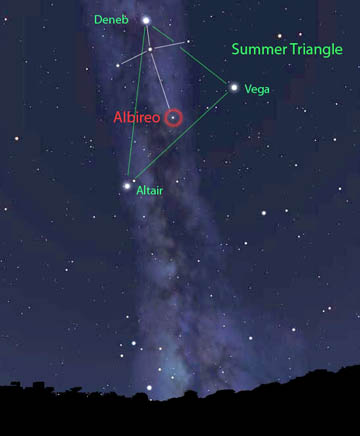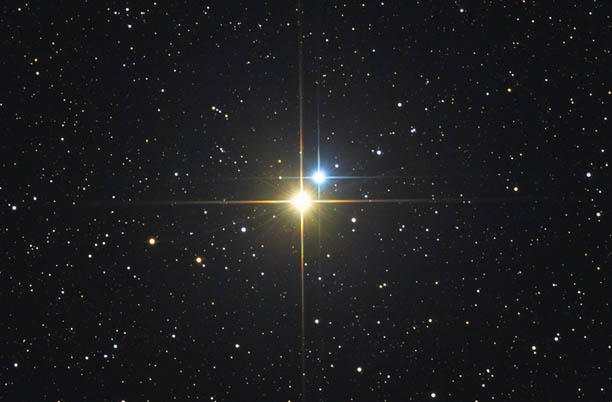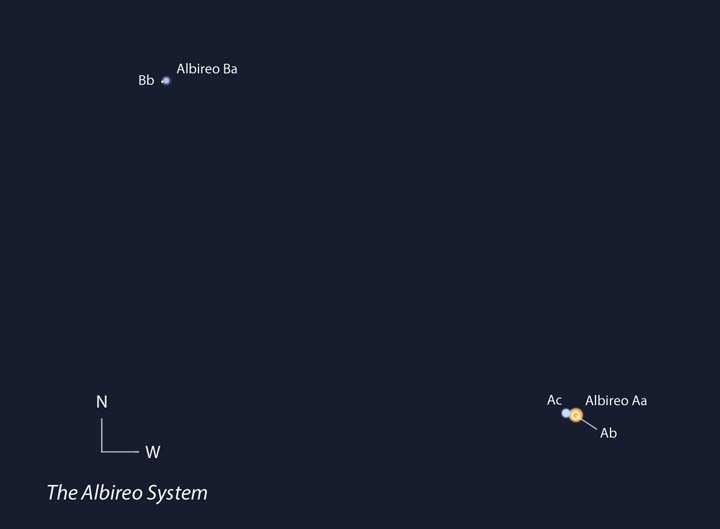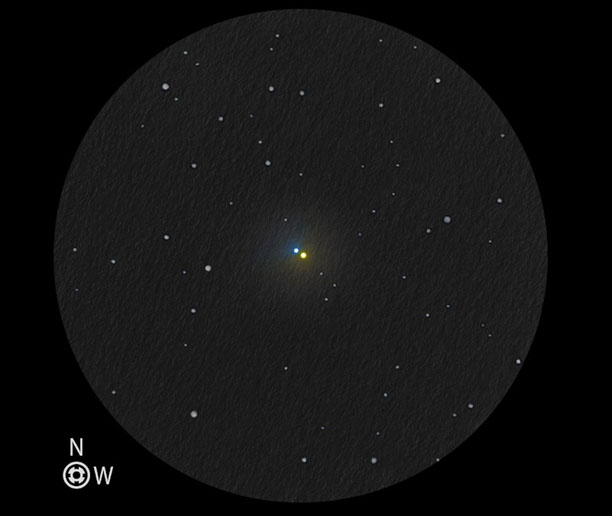A stunning double star, Albireo is also a bit of an enigma. Is it a true binary or the result of a chance alignment? We explore the possibilities.

Stellarium
Ask any amateur astronomer what his or her favorite double star is and chances are they'll sing the praises of Albireo. Also known as Beta (β) Cygni, this bright and colorful duo resides at the foot of the Northern Cross, an asterism within the traditional figure of Cygnus, the Swan. Medieval astronomers knew it as the "hen's beak," which well describes its position at the bill-end of the swan.
Whenever I show friends and family Albireo through the scope, they're struck by the vivid color contrast between the brighter, orange primary and sapphire secondary star located 34″ to its northeast. The pair is set in a rich field aglitter with faint stars, which only deepens its appeal.
The stars' hues fit their spectral classifications rather well: Albireo A is an class K3 orange giant 5 times more massive than the Sun, while Albireo B is a hotter, smaller B8 (blue-white) dwarf with a mass of 3.3 solar.
Either way, any telescope or binoculars will split them. For observers in mid-northern latitudes, vibrant Albireo remains a go-to star for anyone wanting a look at one of the sky's finest jewels. Its northern declination keeps it visible most months of the year, though spring through early fall is best.

Stefan Binnewies / Josef Pöpsel / Capella Observatory
Many of us consider Albireo the quintessential binary star, but do these suns actually orbit about each other, or are we seeing a chance alignment called an optical double? Looking into the literature, we learn that no change in the separation between the two stars has been observed since they were first measured 261 years ago. Nor has the position angle (PA) of the secondary star changed much: 58° to 54°. This slight difference might easily fall within the margin of uncertainty. Albireo's fixed appearance implies an orbital period of at least 75,000 years and probably upward of 100,000 years.
Assuming that's true, we'd have to twiddle our thumbs a long time to measure even a niggling fraction of the secondary's orbital arc. Perhaps there's another way to confirm or deny Albireo's gravitational bond. Both stars occupy the same region of space as they orbit around the galaxy, but their proper motions, that is, the direction each star travels across our line of sight, reveals something very interesting. Instead of coming together, these two appear to be drifting apart.

If you go to the double and multiple star bible, the Washington Double Star Catalog (WDS), and scroll down to 19307+2758 (the star's right ascension [R.A.] and declination [Dec.]), you'll see that Albireo appears to have not one but 14 companions in all! Most are line-of-sight pairings and not physically related. The stars labeled D through L appear to be faint, unrelated field stars. No change in position angle or separation has occurred between observations. Only 11th-magnitude Albireo C has shifted a bit in the past 68 years, but it appears the star is leaving Albireo A behind, so is likely unrelated.

Andrew James
The others? Albireo Aa (the primary) has two additional physical companions named Ab and Ac. Both the Aa-Ab and Aa-Ac pairs were nabbed in the mid-1970s using speckle interferometry. At discovery, Ab glimmered just 0.1″ from the primary and Ac at 0.4″. Both are 5th magnitude. There's no way anyone's going to split Ab, since it's currently 0.0″ seconds from A, but there exists a small possibility that 12-inch and larger scopes under superb seeing conditions might wrest Ac from Albireo's dazzle. I've never known anyone who's successfully tackled the challenge. If you're game and succeed, we'd love to hear how you did it.
In 2002, Albireo B, the bright, blue companion of Albireo, was also found to be a physical binary. The Ba-Bb pair is composed of the bright secondary (magnitude 5) with a 9.2-magnitude companion snugged up 0.4″ to its southeast. Given the four magnitude difference between them, this is well nigh impossible to cleave in even large amateur telescopes.

Illustration: Bob King, Source: Stellarium
When you tally up its true companions, Albireo unfolds into a quintuple star! But hold on. There's still the niggling question of whether the familiar gold and blue suns that charm our eyes off are physically connected. To attempt to get an answer, let's take a closer look at the stars' individual proper motions.
According to the the WDS, every year, the right ascension of Albireo A decreases by 2.0 milliarcseconds (mas) and its declination by 1.0 mas, which means it travels to the west-southwest in PA 244°. Meanwhile, Albireo B, with a yearly proper motion of 1.0 mas to the west and 2.0 mas to the south is headed toward PA 206°, a significantly different direction from the primary. A check on their proper motions in the Simbad database gives an even more extreme value for Albireo A of 7.2 mas (decreasing R.A.) and 6.2 mas (south).
That's not all. The radial velocity — the direction toward or away a star is moving from us — is 24 km/sec for Albireo A and 18.8 km/sec for Albireo B. Both are heading in our direction, but at different speeds.

Jeremy Perez
From all appearances then, the two stars, while relatively near one another and moving through space together, appear to be on separate paths and moving at different velocities, which implies they're unrelated. I don't offer this as absolute proof because measurements can vary, but to date, our favorite double appears to be more like two strangers eyeing one another across the room rather than lovers in binary embrace.
 16
16








Comments
September 21, 2016 at 2:50 pm
Albireo is beautiful. I happened on it by chance. I was looking for the Dumbell Nebula, and came across it. I've followed astronomy off and on for most of my life, but somehow I've missed this. I showed it to my wife. She thought it was beautiful as well, and she's not into astronomy. I'm going to get a little bigger refractor soon(I've a 70mm now) and I'm going to start looking for double stars.
You must be logged in to post a comment.
Bob KingPost Author
September 22, 2016 at 12:16 am
AlphaCen, you'll find so many excellent ones to view through that sized refractor. Enjoy! I can recommend the Cambridge Atlas of Double Stars as well as dropping by the Cloudy Night Double Star Observer Forum.
You must be logged in to post a comment.
Anthony Barreiro
September 21, 2016 at 3:00 pm
Nah. Thousands of people who have looked at Albireo through my little refractor will tell you with complete confidence that they're a binary star, orbiting one another very slowly. I told them so.
Next you're going to tell me that the Earth is actually going around the Sun, when we can see perfectly well that the Sun goes around the Earth.
You must be logged in to post a comment.
Bob KingPost Author
September 22, 2016 at 12:16 am
Anthony, OK, I promise to keep your secret 😉
You must be logged in to post a comment.
Anthony Barreiro
September 22, 2016 at 2:24 pm
I'm afraid the cat's already out of the bag, and the genie's out of the bottle. I'll have to revise my Albireo eyepiece chatter. Darn it.
You must be logged in to post a comment.
Patrick-Thibault
September 21, 2016 at 8:07 pm
Is this like saying Pluto is no longer a planet? It breaks my heart, but the two stars are still pretty looking in a small 'scope.
You must be logged in to post a comment.
Bob KingPost Author
September 22, 2016 at 12:17 am
Patrick,
Well, if nothing else, Albireo will always be the best optical double if that's ultimately what it turns out to be.
You must be logged in to post a comment.
Tom-Reiland
September 23, 2016 at 4:49 pm
Though most astronomers prefer Albireo, I consider WZ Cassiopeiae (Pulkovo 254) as my favorite double star. WZ is a red (carbon) star that varies in brightness from 6.9 (some list its at max 6.5) to 8.5 mag. The companion is a blue star at 8.7 magnitude. I've been observing it for several decades. It is often the last object I observe just before I pack up my telescope. The Greek letter Sigma is the designation for F. G. Wilhelm Struve. Greek letters Omicron and Sigma are for Otto Struve and Omicron, Sigma, Sigma represents double stars catalogued by many observers at the Pulkovo Observatory. I've noticed that some have mistakenly listed the Pulkovo doubles as either Struve or Otto Struve doubles. Check out WZ Cass and you'll see why I enjoy observing it, especially because the primary is a beautiful red variable.
You must be logged in to post a comment.
Bob KingPost Author
September 24, 2016 at 9:38 am
Thank you Tom for suggesting WZ Cas. It sounds like a beauty, and to be honest, I don't think I've observed it before. This colorful double will be at the top of my list the next clear night.
You must be logged in to post a comment.
Pacilio Hugo
October 2, 2016 at 12:55 pm
Hello, these two stars are really beautiful, I have no telescope, but if so, it would be the first targets to be observed astronomically, these two stars have their cosmic beauty.
You must be logged in to post a comment.
Bob KingPost Author
October 2, 2016 at 2:06 pm
Pacilio, Albireo makes a perfect first astronomical "target".
You must be logged in to post a comment.
Eric Rachut
July 18, 2018 at 1:05 pm
If Albireo A and B constitute a binary star, it would seem that their proper motions would be a combination of the stars's inherent motion through space and their motion around the barycenter, as well as the orientation of the orbit to our line of sight. I wonder if there is a mathematical way of determining if such an orbit, of a binary star, could explain the differences mentioned in this article.
You must be logged in to post a comment.
Bob KingPost Author
July 19, 2018 at 6:38 pm
Tex,
This is a very interesting question. But I wonder if the simple fact that they're both headed toward Earth at different speeds wouldn't eliminate the possibility that they're related. If they revolved around a barycenter, it would seem one would be receding and the other approaching. Or am I missing something?
You must be logged in to post a comment.
Eric Rachut
December 4, 2018 at 4:21 pm
The orbital motions of the two would be opposing (one receding and the other approaching). If the orbital motion is less than the common proper motion towards the Earth, which seems likely, then the two stars would each have a combined (proper and orbital) motion towards the Earth, but the combined motion of the two stars would be different.
You must be logged in to post a comment.
joey1979
November 24, 2022 at 11:39 pm
Albireo inspired me to marry my wife who is of a different skin colour and culture. We have been married for 36 years now. Now you tell me that the stars are not ‘lovers in a binary embrace’. Scoundrel!
You must be logged in to post a comment.
Dave Mitsky
December 22, 2023 at 10:29 pm
Almach (Gamma Andromedae) is similar to Albireo but is a tighter double star. The already mentioned WZ Cassiopeiae is very colorful and is one of my favorites, along with h3945 (the Winter Albireo), Eta Cassiopeiae, and Iota Cancri.
You must be logged in to post a comment.
You must be logged in to post a comment.